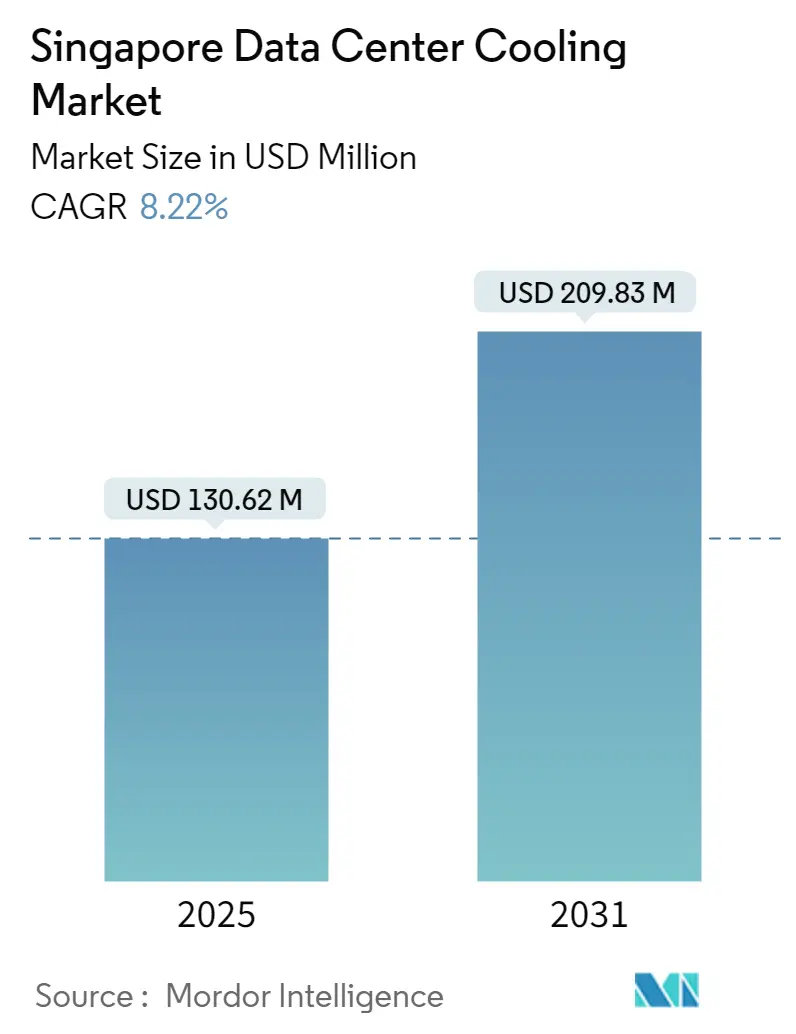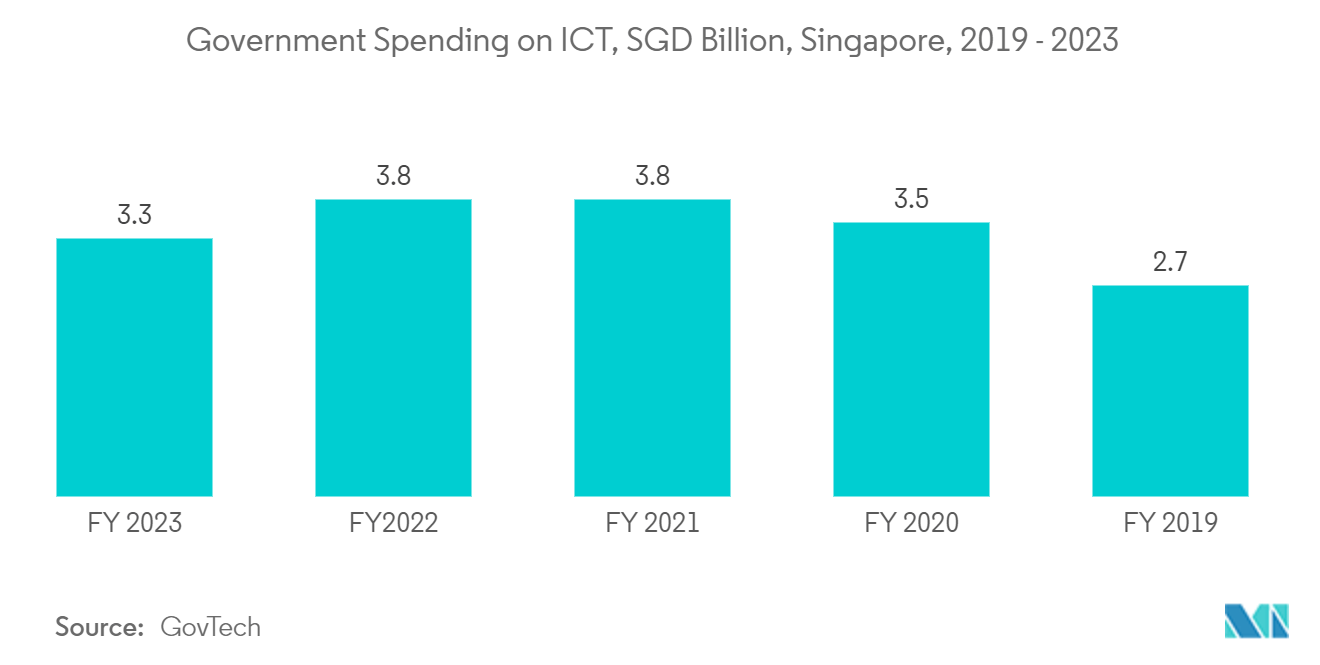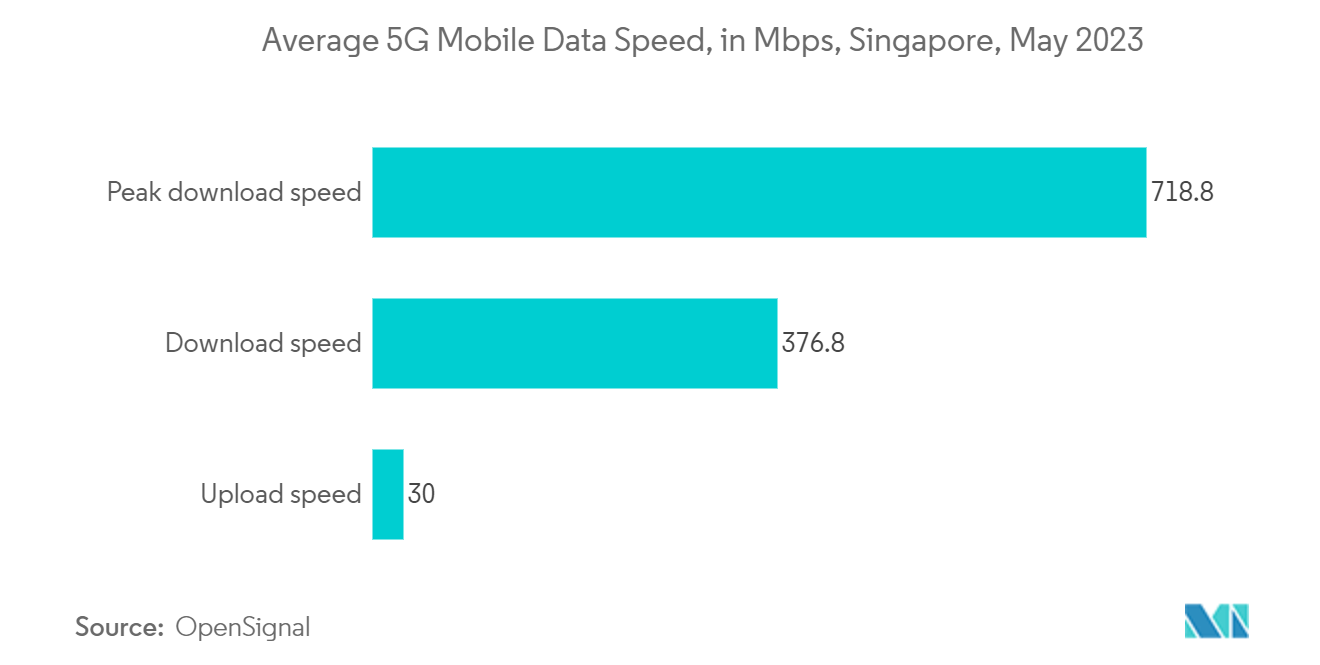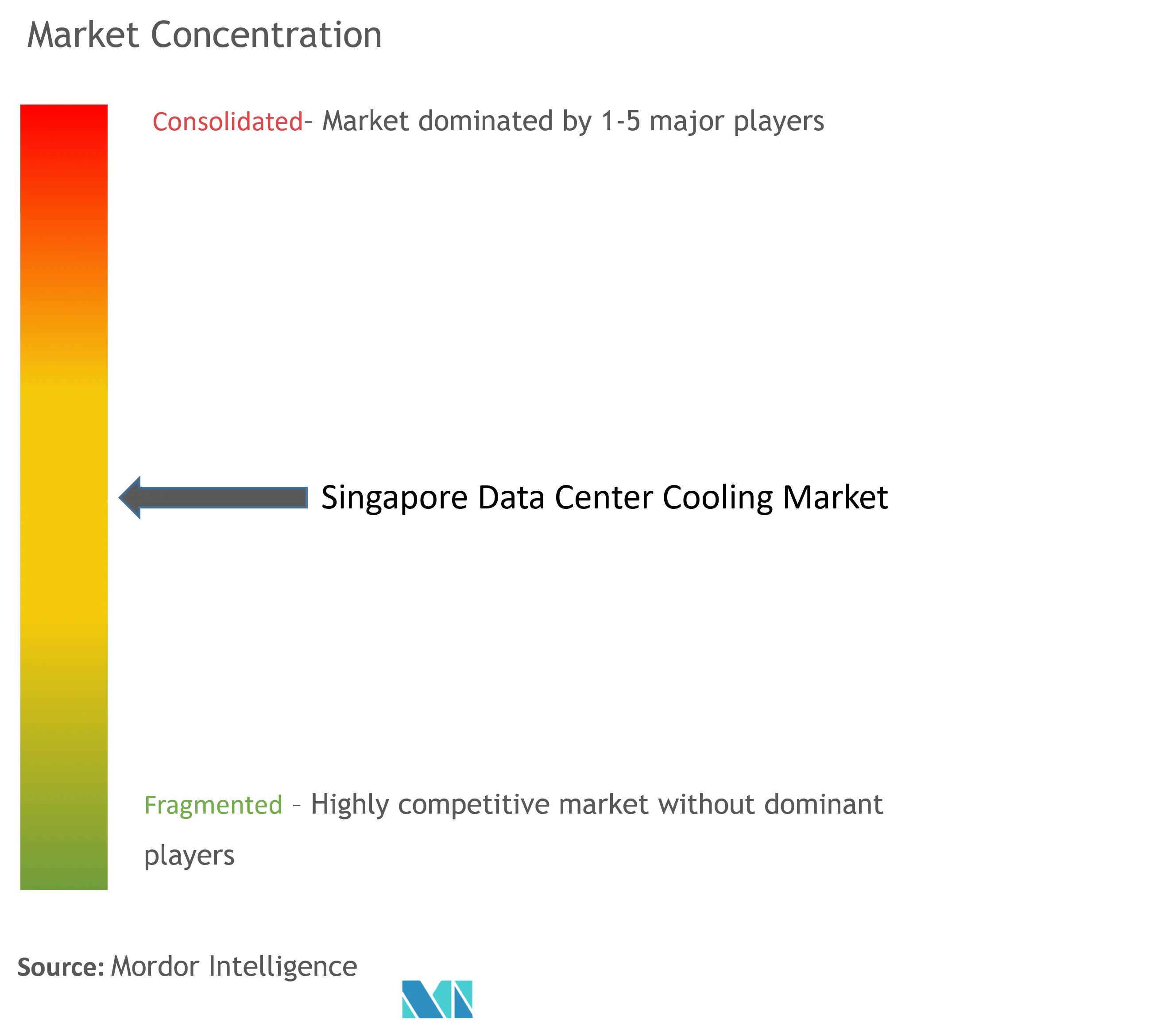Singapore Data Center Cooling Market Size and Share

Singapore Data Center Cooling Market Analysis by Mordor Intelligence
The Singapore Data Center Cooling Market size is estimated at USD 130.62 million in 2025, and is expected to reach USD 209.83 million by 2031, at a CAGR of 8.22% during the forecast period (2025-2031).
- The increasing demand for cloud computing among SMEs, government regulations for local data security, and growing investment by domestic players are some of the major factors driving the demand for data centers in the country.
- The upcoming IT load capacity of the Singapore data center market is expected to reach more than 1000 MW by 2030. The country's construction of raised floor area is expected to increase above 3.3 million sq. ft by 2030.
- The country's total number of racks to be installed is expected to reach above 1,65,000 units by 2030. East and West Singapore are expected to house the maximum number of racks by 2030. The climate in Singapore is hot, muggy, and cloudy. Throughout the year, temperatures typically fluctuate between 24 and 30°C, rarely dropping below 24°C or above 30°C. Depending upon climatic conditions, the DC cooling is processed in the DC facilities.
- There are close to 76 submarine cable systems connecting Singapore, and many are under construction. In June 2023, with three new landing sites, Singapore announced plans to double its submarine cable capacity over the next decade.
Singapore Data Center Cooling Market Trends and Insights
Liquid-based Cooling is the Fastest Growing Segment
- Liquid cooling takes advantage of the superior heat transfer properties of water or other liquids to support efficient and cost-effective cooling of high-density racks, up to 3000 times more effective than using air. Long proven in mainframe and gaming applications, liquid cooling is increasingly being used to protect rack servers in data centers across the region.
- Technological advancements are carried out in the data center cooling sector within the country. For instance, in August 2023, Digital Realty used electrolysis to purify the water used in Singapore's cooling towers, saving over 1 million liters each month. The company treats its SIN10-dated cooling water using electrolysis rather than chemicals. This prevents scaling and allows water to flow through the cooling system more often before being discharged as wastewater.
- Technological advances have made liquid cooling easier to maintain, more scalable, and more affordable, reducing data center liquid consumption by more than 15% in tropical climates and by 80% in greener areas. The energy used for liquid cooling can be recycled to heat buildings and water, and advanced artificial refrigerants can effectively reduce the carbon footprint of air conditioners.
- Further, in April 2023, NTU scientists developed this new method that combines highly efficient heat dissipation mechanisms such as evaporation and boiling to directly cool the central processing unit (CPU) using a spray of non-conductive liquids without heat sinks. The gas and excess liquid are then collected in a closed system, condensed to a liquid at tropical ambient temperatures (approximately 30°C), and returned to the system for reuse.
- Water cooling can be essential in minimizing emissions and reducing climate disturbance. Data centers using water as a cooling substance use about 10% less energy than most air-cooled data centers, emitting about 10% less CO2. In 2021, water cooling could reduce energy-related CO2 emissions in the data center portfolio by about 300,000 tonnes. Thus, technological advancement, benefits of liquid cooling, and growth in DC facilities would increase the demand for liquid cooling in DC facilities in the country.

IT & Telecommunication is The Largest Segment
- The Singapore government is pivotal in stimulating demand and utilization of technology and telecommunications across the country by launching forward-thinking projects such as the Smart Nation Initiative, Digital Economy Framework, Digital Government Blueprint, and Industrial Transformation Map.
- Singapore continues to roll out 5G. 5G networks and services are expected to be the cornerstone of the telecom industry's development over the next few years as service providers look for new ways to attract customers to the market. Singapore is expected to expand standalone 5G coverage to seaports such as anchorages, fairways, terminals, and wharves by mid-2025 to facilitate 5G deployment in shipping.
- Singapore's road to becoming a smart nation started in 2014 to improve people's lives and open up new opportunities. Governments are using cutting-edge technologies and solutions to modernize city-states in terms of healthcare, transportation, urban life, government services, and businesses. Since then, Singapore has adopted several digital strategies and regulations and has implemented significant national projects and initiatives to boost productivity while focusing on sustainability.
- Furthermore, Chinese cloud service provider Alibaba Cloud has launched its cloud computer in Singapore, eliminating the need for powerful desktop hardware to perform compute-intensive tasks. All connectivity and storage will be managed by Alibaba Cloud, which is targeting organizations involved in medical research, financial modeling, and oil and gas simulations, among other use cases. Such instances are expected to increase the demand for the cloud industry in the market.
- Government Technology Agency of Singapore primarily focuses on the digital transformation of the public sector using advanced data and communication tech to improve the daily lives of Singaporeans. Plans such as the Smart Nation Initiative, the Digital Economy Framework, the Digital Government Blueprint, and the Industrial Transformation Map (ITM) continue to drive the demand for technology and telecommunications adoption across the country.

Competitive Landscape
The Singapore data center cooling market is moderately competitive and has gained a competitive edge in recent years. Currently, a handful of major players, including Stulz GmbH, Schneider Electric SE, Vertiv Group Corp., Rittal GmbH & Co. KG, and Mitsubishi Electric Hydronics & IT Cooling Systems SpA, dominate the market in terms of market share. These industry giants, boasting significant market shares, are actively engaged in expanding their customer base throughout the region. Their growth strategies primarily hinge on strategic collaborative efforts aimed at enhancing market share and overall profitability. Moreover, companies such as Schneider Electric SE, Johnson Controls Inc. offer both liquid and air based cooling products.
Singapore Data Center Cooling Industry Leaders
-
Stulz GmbH
-
Schneider Electric SE
-
Vertiv Group Corp.
-
Rittal GmbH & Co. KG
-
Mitsubishi Electric Hydronics & IT Cooling Systems SpA
- *Disclaimer: Major Players sorted in no particular order

Recent Industry Developments
- March 2023: Interactive, a managed service provider, introduced its groundbreaking Immersion Data Center Cooling solution aimed at enhancing high-performance computing (HPC) capabilities for its clientele. Collaborating closely with digital infrastructure provider Vertiv, Interactive has incorporated Green Revolution cooling tanks into its system. These tanks employ a single-phase, non-conductive coolant known for its electrical component safety and impressive heat transfer capacity, which surpasses that of air by a factor of 1200.
- March 2023: LiquidStack secured a significant investment from HVAC firm Trane Technologies to push the boundaries of immersion cooling technology. LiquidStack's exclusive liquid immersion cooling technology sets a new standard for sustainable data center cooling. These innovative cooling solutions align with the company's ambitious sustainability goals, including a commitment to reducing carbon emissions within its customer ecosystem by 1 billion tons by 2030 and achieving net-zero emissions by 2050.
Singapore Data Center Cooling Market Report Scope
Data center cooling is a set of techniques and technologies to maintain optimal operating temperatures in data center environments. Data center cooling is critical as data center facilities house many computer servers and network equipment that generate heat during operation. Efficient cooling systems are used to dissipate this heat and prevent equipment from overheating, ensuring continued reliable operation of the data center. Various methods, such as air conditioning, liquid cooling, and hot/cold aisle containment, are commonly used to control temperature and humidity in data centers.
The Singapore Data Center cooling market study comprises by Technology (Air-based cooling (Chiller and Economizer, CRAH, Cooling Towers and Others), Liquid-based cooling (Immersion Cooling, Direct-to-chip Cooling, Rear-Door Heat Exchanger)), type of data center (Hyperscaler, Enterprise and Colocation) , by End-User Industry(IT & Telecom, Retail & Consumer Goods, Healthcare, Media & Entertainment, Federal & Institutional agencies, and Other end-users).
The market sizes and forecasts are provided in values of USD for all the above segments.
| Air-based Cooling | Chiller and Economizer |
| CRAH | |
| Cooling Tower (covers direct, indirect & two-stage cooling) | |
| Others | |
| Liquid-based Cooling | Immersion Cooling |
| Direct-to-Chip Cooling | |
| Rear-Door Heat Exchanger |
| Hyperscalers (owned & Leased) |
| Enterprise (On-premise) |
| Colocation |
| IT & Telecom |
| Retail & Consumer Goods |
| Healthcare |
| Media & Entertainment |
| Federal & Institutional agencies |
| Other end-users |
| By Cooling Technology | Air-based Cooling | Chiller and Economizer |
| CRAH | ||
| Cooling Tower (covers direct, indirect & two-stage cooling) | ||
| Others | ||
| Liquid-based Cooling | Immersion Cooling | |
| Direct-to-Chip Cooling | ||
| Rear-Door Heat Exchanger | ||
| By Type | Hyperscalers (owned & Leased) | |
| Enterprise (On-premise) | ||
| Colocation | ||
| By End user Vertical | IT & Telecom | |
| Retail & Consumer Goods | ||
| Healthcare | ||
| Media & Entertainment | ||
| Federal & Institutional agencies | ||
| Other end-users | ||
Key Questions Answered in the Report
How big is the Singapore Data Center Cooling Market?
The Singapore Data Center Cooling Market size is expected to reach USD 130.62 million in 2025 and grow at a CAGR of 8.22% to reach USD 209.83 million by 2031.
What is the current Singapore Data Center Cooling Market size?
In 2025, the Singapore Data Center Cooling Market size is expected to reach USD 130.62 million.
Who are the key players in Singapore Data Center Cooling Market?
Stulz GmbH, Schneider Electric SE, Vertiv Group Corp., Rittal GmbH & Co. KG and Mitsubishi Electric Hydronics & IT Cooling Systems SpA are the major companies operating in the Singapore Data Center Cooling Market.
What years does this Singapore Data Center Cooling Market cover, and what was the market size in 2024?
In 2024, the Singapore Data Center Cooling Market size was estimated at USD 119.88 million. The report covers the Singapore Data Center Cooling Market historical market size for years: 2019, 2020, 2021, 2022, 2023 and 2024. The report also forecasts the Singapore Data Center Cooling Market size for years: 2025, 2026, 2027, 2028, 2029, 2030 and 2031.
Page last updated on:
Singapore Data Center Cooling Market Report
Statistics for the 2025 Singapore Data Center Cooling market share, size and revenue growth rate, created by Mordor Intelligence™ Industry Reports. Singapore Data Center Cooling analysis includes a market forecast outlook for 2025 to 2031 and historical overview. Get a sample of this industry analysis as a free report PDF download.



